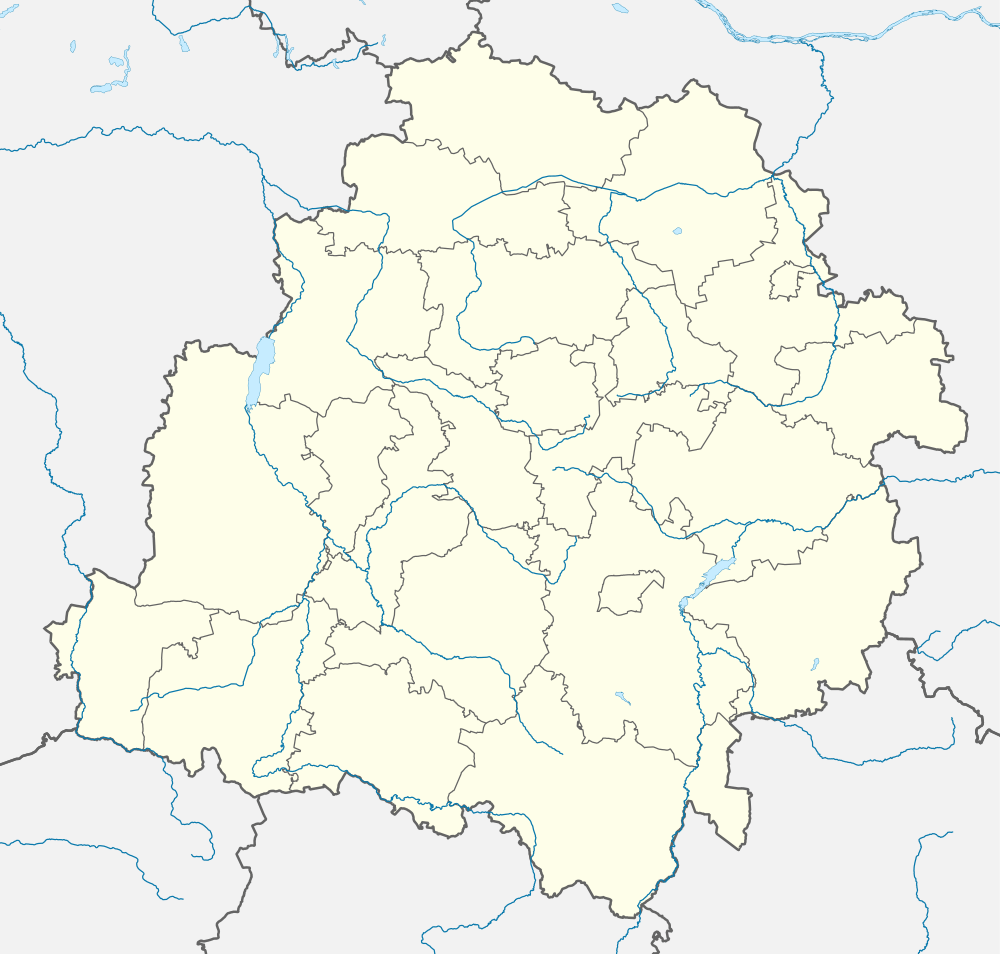Zduńska Wola
Zduńska Wola [ˈzduɲska ˈvɔla] is a town in central Poland with 42,698 inhabitants (2016).[1] Situated in the Łódź Province (since 1999), previously in Sieradz Province (1975–1998). It is the seat of Zduńska Wola County. The town was once one of the largest cloth, linen and cotton weaving centres in Poland and is the birthplace of Saint Maximilian Kolbe and Maksymilian Faktorowicz, the founder of Max Factor cosmetics company.[2]
Zduńska Wola | |
|---|---|
_Lichen99.jpg) Train station in Zduńska Wola | |
 Flag  Coat of arms | |
 Zduńska Wola  Zduńska Wola | |
| Coordinates: 51°36′N 18°58′E | |
| Country | |
| Voivodeship | |
| County | Zduńska Wola County |
| Gmina | Zduńska Wola (urban gmina) |
| Government | |
| • Mayor | Konrad Pokora |
| Area | |
| • Total | 24.58 km2 (9.49 sq mi) |
| Population (31.12.2016) | |
| • Total | 42,698 |
| • Density | 1,700/km2 (4,500/sq mi) |
| Time zone | UTC+1 (CET) |
| • Summer (DST) | UTC+2 (CEST) |
| Postal code | 98-220 |
| Car plates | EZD |
| Website | http://www.zdunskawola.pl |
History
Early history

The town was first mentioned and documented in 1394. Zduńska Wola was then part of an important trade route which crossed through Poland and connected Eastern and Western Europe. Over the course of its history, the town was owned by nobles or industrialists and eventually transformed into a shtetl. At the beginning of the 18th century, Zduńska Wola was purchased by the aristocratic Złotnicki family.[3]
The development of the village is closely linked with the rapid influx of Silesian weavers and textile workers. In 1817, with the contribution and effort of Stefan Złotnicki, the village flourished and became populated with migrants from Silesia, Germany and Bohemia. In 1824 the town's population reached 1,400 people, including 150 professional textile laborers in 125 private workshops.[3] Following rapid development, Zduńska Wola received town rights in October 1825.
In 1827 the population had reached 2,758 people and the town possessed 320 buildings, however, only 30 were made of brick or stone.[3] Due to the lack of available space for incoming weavers, the town was expanded and new districts were established by incorporating nearby villages and settlements.
Industrial development
The end of the 19th century was a period of dynamic development, which eventually transformed the rural town into a small industrial centre. In 1909 the population was already 22,504 people. Over 50 new industrial enterprises or textile corporations were set up, which employed 5,200 workers. Zduńska Wola gained the nickname "City of Weavers" and from the 1,360 buildings now standing, approximately 600 were made of brick. In 1892 the first steam brewery was constructed, which contributed to the town's importance in the region. Under the patronage of the Złotnicki family and local business owners, Zduńska Wola was completely remodelled and urbanized; new housing estates were built for the workers and the first city park was opened during this period.[4]
In 1903 the region was connected with Kalisz and Łódź by rail. In 1902 Zenon Anstadt, a member of a wealthy family of brewers from Łódź, was responsible for the continuous development of the town's infrastructure. Shortly before the outbreak of World War I in 1914, the population of the city was 28,437 people. Under the Imperial German occupation, the city's population fell to just 12,000 in 1918.
Second Polish Republic
After Poland's independence, the city with its industries was rebuilt from the devastation of war. Alongside the former textile industry, new metallurgical enterprises, power plants, public schools, gymnasiums, city hospital and a fire station were established. In 1930 Zduńska Wola became an important transport hub, when it was connected by rail with the Polish port of Gdynia on the Baltic Sea. By 1939 Zduńska Wola was the largest city in the western part of Łódź Voivodeship (province).[3]
After the invasion of Poland in September 1939, the German occupiers changed the town's name to Freihaus and incorporated it into the Wartheland of Nazi Germany.[5]
Nearly all members of the prominent and large Jewish population of Zduńska Wola of around 8000 at the beginning of the war were murdered as part of the Holocaust[6] On arrival of the German troops in September, 1939, local ethnic Germans and Poles looted Jewish property. The Germans shot several Jews at that time and burned the synagogue. Over the next several months, the Jewish community was robbed, brutalized, and confined to a ghetto area. During 1940 and 1941, Jews from other locations were moved into the ghetto which population increased to around 11,000, crowded together and may without means of support. In August, 1942, the Jewish population were gathered together. Several hundred were sent to the Lodz ghetto. Hundreds were shot in the Zduńska Wola cemetery. More than 6000 and perhaps as many as 9000 were sent to the Chelmno killing camp where they were immediately gassed.
About 60 of Zduńska Wola's Jewish population are thought to have survived the war. The German administrator who oversaw the final selection, Hans Biebow, was tried, convicted, and executed after the war for his crimes in Lodz and Zduńska Wola. In contrast, the head of the Jewish council in the town was lauded for his uprightness. Murdered by Biebow after the selection in August, he had refused to collaborate with the Germans or betray his fellow Jews.[7]
The town also suffered heavy destruction in the war.
Education
Primary Schools
High Schools
Twin towns - Sister cities
Zduńska Wola is twinned with:[8]



Famous people from Zduńska Wola
- Danuta Dudzińska-Wieczorek
- Max Factor, Sr.
- Magda Femme
- Riwka Herszberg
- Maximilian Kolbe
- Lazar Lyusternik
- Justyna Majkowska
References
- Population. Size and Structure and Vital Statistics in Poland by Territorial Division in 2016, as of December 31 (PDF). Warszawa: Główny Urząd Statystyczny. 2017. p. 118. ISSN 2451-2087.
- "Local history - Information about the town - Zduńska Wola - Virtual Shtetl". www.sztetl.org.pl. Retrieved 25 August 2017.
- "Historia". zdunskawola.pl. Retrieved 25 August 2017.
- User, Super. "Historia Zduńskiej Woli". lepczynski.eu. Retrieved 25 August 2017.
- User, Super. "Historia Zduńskiej Woli". lepczynski.eu. Retrieved 25 August 2017.
- "Historia miejscowości - Informacje o mieście - Zduńska Wola - Wirtualny Sztetl". www.sztetl.org.pl. Retrieved 25 August 2017.
- Megargee, Geoffrey (2012). Encyclopedia of Camps and Ghettos. Bloomington, Indiana: University of Indiana Press. p. Volume II 121-124. ISBN 978-0-253-35599-7.
- "Współpraca zagraniczna". zdunskawola.pl (in Polish). Zduńska Wola. Retrieved 2019-09-21.


